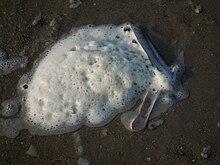| Phaeocystis | |
|---|---|

| |
| Phaeocystis globosa | |
| Scientific classification | |
| Domain: | |
| (unranked): | |
| Class: | |
| Order: | |
| Family: | |
| Genus: | Phaeocystis Lagerheim, 1893
|
Phaeocystis is a genus of algae belonging to the Prymnesiophyte class and to the larger division of Haptophyta.[1] It is a widespread marine phytoplankton and can function at a wide range of temperatures (eurythermal) and salinities (euryhaline).[2] Members of this genus live in the open ocean, as well as in sea ice.[3] It has a polymorphic life cycle, ranging from free-living cells to large colonies.[2]
The ability to form a floating colony is one of the unique attributes of Phaeocystis – hundreds of cells are embedded in a polysaccharide gel matrix, which can increase massively in size during blooms.[3] The largest Phaeocystis blooms form in the polar seas: P. pouchetii in the north and P. antarctica in the south.[1] This intense Phaeocystis productivity generally persists for about a three-month period, spanning most of the summer in the Southern Hemisphere. Phaeocystis-abundant ecosystems are generally associated with commercially important stocks of crustaceans, molluscs, fish and mammals. Phaeocystis may have negative effects on higher trophic levels in the marine ecosystem, and consequent impacts on human activities (such as fish farming and coastal tourism), by forming odorous foams on beaches during the wane of a bloom.[4]
The ability to form large blooms and its ubiquity make Phaeocystis an important contributor to the ocean carbon cycle.[5][6] In addition, Phaeocystis produces dimethyl sulfide (DMS), a key player in the sulfur cycle.[7][8]
- ^ a b "phaeocystis research". www.phaeocystis.org.
- ^ a b Schoemann, Véronique; Becquevort, Sylvie; Stefels, Jacqueline; Rousseau, Véronique; Lancelot, Christiane (2005-01-01). "Phaeocystis blooms in the global ocean and their controlling mechanisms: a review". Journal of Sea Research. Iron Resources and Oceanic Nutrients - Advancement of Global Environmental Simulations. 53 (1–2): 43–66. Bibcode:2005JSR....53...43S. CiteSeerX 10.1.1.319.9563. doi:10.1016/j.seares.2004.01.008.
- ^ a b "Welcome to the Phaeocystis antarctica genome sequencing project homepage". www.phaeocystis.org.
- ^ Lancelot, C; Mathot, S (1987). "Dynamics of a Phaeocystis-dominated spring bloom in Belgian coastal waters. I. Phytoplanktonic activities and related parameters". Marine Ecology Progress Series. 37: 239–248. Bibcode:1987MEPS...37..239L. doi:10.3354/meps037239.
- ^ Smith, Walker O.; Codispoti, Louis A.; Nelson, David M.; Manley, Thomas; Buskey, Edward J.; Niebauer, H. Joseph; Cota, Glenn F. (1991-08-08). "Importance of Phaeocystis blooms in the high-latitude ocean carbon cycle". Nature. 352 (6335): 514–516. Bibcode:1991Natur.352..514S. doi:10.1038/352514a0. S2CID 4369806.
- ^ DiTullio, G. R.; Grebmeier, J. M.; Arrigo, K. R.; Lizotte, M. P.; Robinson, D. H.; Leventer, A.; Barry, J. P.; VanWoert, M. L.; Dunbar, R. B. (2000). "Rapid and early export of Phaeocystis antarctica blooms in the Ross Sea, Antarctica". Nature. 404 (6778): 595–598. Bibcode:2000Natur.404..595D. doi:10.1038/35007061. PMID 10766240. S2CID 4409009.
- ^ Stefels, J., Van Boekel, W.H.M., 1993. Production of DMS from dissolved DMSP in axenic cultures of the marine phytoplankton species Phaeocystis sp., Mar. Ecol. Prog. Ser. 97, 11 –18.
- ^ J, Stefels; L, Dijkhuizen; WWC, Gieskes (1995-07-20). "DMSP-lyase activity in a spring phytoplankton bloom off the Dutch coast, related to Phaeocystis sp. abundance" (PDF). Marine Ecology Progress Series. 123: 235–243. Bibcode:1995MEPS..123..235S. doi:10.3354/meps123235.
